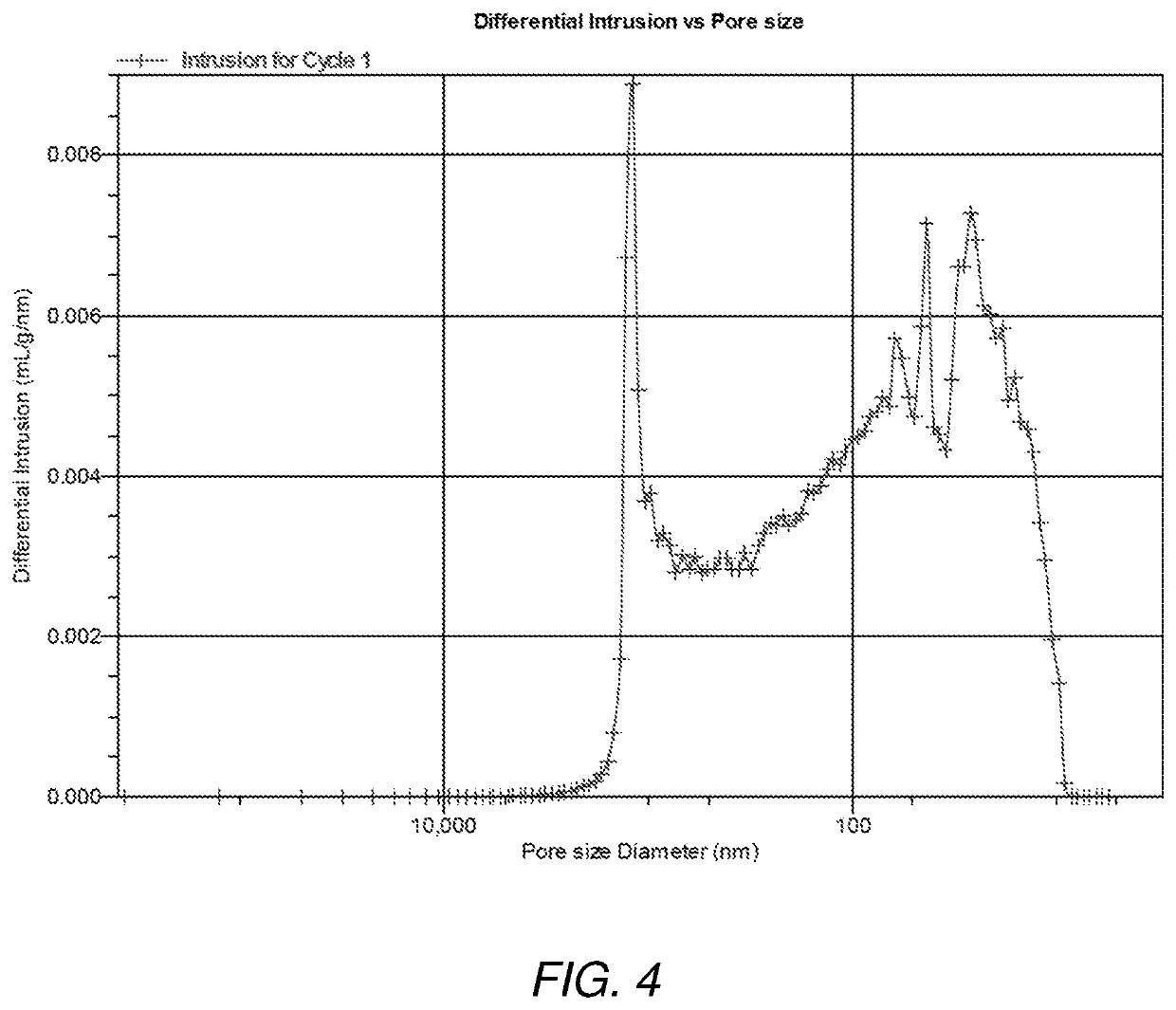Thermally treated polyamic amide aerogel
- Summary
- Abstract
- Description
- Claims
- Application Information
AI Technical Summary
Benefits of technology
Problems solved by technology
Method used
Image
Examples
example 1
Preparation of a Highly Branched Polyamic Acid
[0102]A reaction vessel with a mechanical stirrer and a water jacket was employed. The flow of the water through the reaction vessel jacket was adjusted to maintain temperature in the range of 20-28° C. The reaction vessel was charged with dimethylsulfoxide (DMSO) (108.2 lbs. 49.1 kg), and the mechanical stirrer speed was adjusted to 120-135 rpm. 1,3,5-tris(4-aminophenoxy)benzene (TAPOB, 65.03 g) was added to the solvent. To the solution was added 4,4′-diamino-2,2′-dimethylbiphenyl (DMB, 1,080.96 g), followed by 4,4′-oxydianiline (ODA, 1,018.73 g). A first portion of biphenyl-tetracarboxylic acid dianhydride (BPDA) (1,524.71 g) was added. After stirring for 20 minutes, a sample of the reaction mixture was analyzed for viscosity. A second portion of BPDA (1,420.97 g) was added, and the reaction mixture was stirred for 20 additional minutes. A sample of the reaction mixture was analyzed for viscosity. A third portion of BPDA (42.81 g) was ...
example 2
Preparation of a Highly Branched Polyamic Amide Aerogel Film
[0103]The resin (10,000 grams) prepared in Example 1 was mixed with 2-methylimidazole (250 grams) for five minutes. Benzoic anhydride (945 grams) was added, and the solution mixed an additional five minutes. After mixing, the resultant solution was poured onto a moving polyester substrate that was heated in an oven at 100° C. for 30 seconds. The gelled film was collected and placed into an acetone bath. After immersion for 24 hours, the acetone bath was exchanged for fresh acetone. The soak and exchange process was repeated six times. After the final exchange, the gelled film was removed. The acetone solvent was evaporated under a stream of air at room temperature, and subsequently dried for 2 hrs hours at 200° C. The final recovered aerogel part had open-cell structure as observed by scanning electron microscopy (SEM) performed on a Phenom Pro Scanning Electron Microscope (Phenom-World, the Netherlands), exhibited a densit...
example 3
Preparation of a Highly Branched Polyamic Amide
[0104]The reaction vessel as described in Example 1 was charged with dimethylsulfoxide (DMSO) (108.2 lbs. 49.1 kg), and the mechanical stirrer speed was adjusted to 120-135 rpm. 1,3,5-tris(4-aminophenoxy)benzene (TAPOB, 65.93 g) was added to the solvent. To the solution was added 4,4′ -diamino-2,2′ -dimethylbiphenyl (DMB, 1,081.64 g), followed by 4,4′-oxydianiline (ODA, 1,020.23 g). A first portion of BPDA (1,438.35 g) was added. After stirring for 20 minutes, a sample of the reaction mixture was analyzed for viscosity. A second portion of BPDA (1,407.77 g) was added, and the reaction mixture was stirred for 20 additional minutes. A sample of the reaction mixture was analyzed for viscosity. A third portion of BPDA (74.35 g) was added, and the reaction mixture was stirred for 20 additional minutes. A sample of the reaction mixture was analyzed for viscosity. After stirring for 8 hours, phthalic anhydride (PA, 174.00 g) was added. The res...
PUM
| Property | Measurement | Unit |
|---|---|---|
| Temperature | aaaaa | aaaaa |
| Temperature | aaaaa | aaaaa |
| Temperature | aaaaa | aaaaa |
Abstract
Description
Claims
Application Information
 Login to View More
Login to View More - Generate Ideas
- Intellectual Property
- Life Sciences
- Materials
- Tech Scout
- Unparalleled Data Quality
- Higher Quality Content
- 60% Fewer Hallucinations
Browse by: Latest US Patents, China's latest patents, Technical Efficacy Thesaurus, Application Domain, Technology Topic, Popular Technical Reports.
© 2025 PatSnap. All rights reserved.Legal|Privacy policy|Modern Slavery Act Transparency Statement|Sitemap|About US| Contact US: help@patsnap.com



